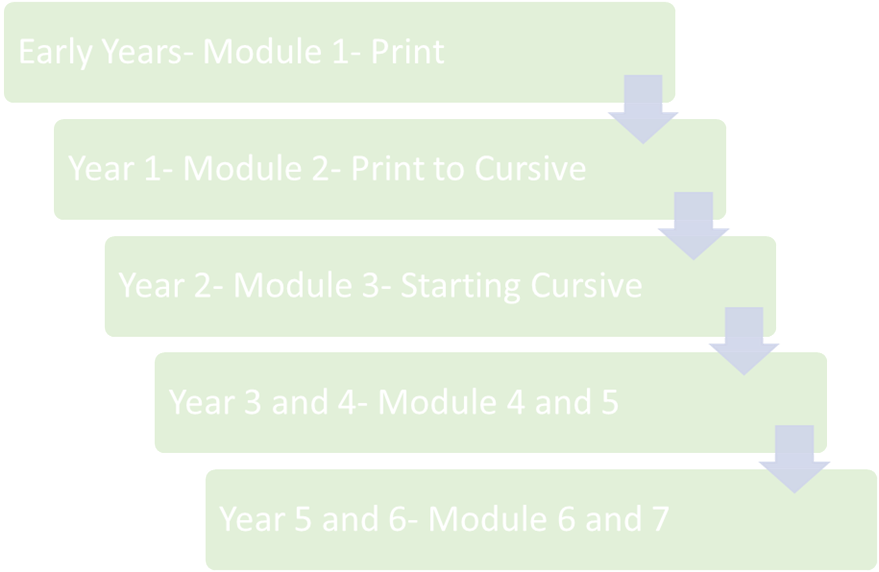Handwriting
At Broomwood Primary School we are very proud of our pupil’s handwriting and take particular care in our handwriting style. We use Letter-join’s on-line handwriting resource and Lesson Planners as the basis of our handwriting policy as it covers all the requirements of the National Curriculum.
Objective
Handwriting is a basic skill that influences the quality of work throughout the curriculum. By the end of Key Stage 2 all pupils should have the ability to produce fluent, legible and, eventually, speedy joined-up handwriting, and to understand the different forms of handwriting used for different purposes.
Intent
Our intention is to make handwriting an automatic process that does not interfere with creative and mental thinking. Through developing automaticity, cognitive load can be released which children can use to focus on creativity.
Ou key intentions are:
- To develop a neat, legible, speedy handwriting style using continuous cursive letters, which leads to producing letters and words automatically in independent writing.
- To establish and maintain high expectations for the presentation of written work.
- For pupils to understand, by the end of Year 6, the importance of neat presentation and the need for different letterforms (cursive, printed or capital letters) to help communicate meaning clearly.
Implement
Handwriting at Broomwood Primary School is taught in a progressive way, in-line with the curriculum set down by Letterjoin. The length and frequency of lessons also changes within different year groups, ensuring that teaching and learning is as effective as it can be for each specific year group.
Progression of Handwriting at Broomwood Primary School

EYFS
Module 1 Print: Early Years teaches handwriting using the printed method. It starts with fine and gross motor skills warm-up exercises, correct sitting position and tripod pencil grip.
It is divided into three sections covering:
• pre-writing patterns
• easy letters and words
• harder letters and words
At the end of this module, children should be able to recognise and form all the printed, lowercase letters of the alphabet.
Key Stage 1: Years 1 and 2
Teaching progresses from five short, to 2 longer lessons per week and Year 1 and 1 longer lesson per week in Year 2:
- continuing with gross and fine motor skills exercises
- strengthening handwriting, learning and practice
- numerals, capitals and printed letters; where and when to use, learning and practice
- KS1 SATs SPaG exercises
Module 2 Print to Cursive (Year 1) teaches how to correctly write capital letters, uses of printed letters, numbers, punctuation, maths symbols and other symbols. Pre-cursive patterns and cursive letters are then introduced in preparation for Module 3 when children are required to start joining their handwriting.
It is divided into three sections covering:
• warm-ups, letter families and capital letters
• uses of printed letters
• numbers and symbols
• introducing pre-cursive patterns and cursive letters
On finishing this module, children should be confident in writing all the capital and printed letters, numbers and symbols and start to become familiar with the orientation of cursive letters.
Module 3 – Starting Cursive (Year 2) introduces children to cursive letters and how to join them. They will have regular practice in letter formation and joining their handwriting.
The sections in this module cover:
- cursive letters and words
- letter families
- high frequency words
- joining techniques
- sequencing sentences
- dictation exercises
- times table facts
• SPaG practice for KS1 SATs
With the regular handwriting practice throughout this module, children should now be developing the fluency and speed of their writing.
Lower Key Stage 2: Years 3 and 4
Handwriting lessons will continue with 1 longer lesson per week in Lower Key Stage 2.
Module 4 (Year 3) is targeted at children in lower KS2 where pupils should be using a cursive style throughout their independent writing in all subjects, helping to refine their handwriting in line with the requirements of each lesson. This module covers topics such as dictation, double letters, number vocabulary, palindromes, tongue twisters, MFL (Spanish), onomatopoeia, simile and statutory spellings.
Completion of Module 4 should ensure improvement in the legibility, consistency and quality of the children’s handwriting through a variety of resources which link handwriting to other areas of the curriculum.
Module 5 (Year 4) focuses on using handwriting practice to support other subjects in the curriculum and, at the same time, builds on fluency and consistency. This module aims to promote meaningful links with other subjects such as English, maths, science, geography, French and Spanish. Making such links enables children to apply the skills they are learning in context and also provides depth to the curriculum.
Learners will continue to build on producing fluent, consistent and legible handwriting through the regular practice offered in this module’s lessons.
On concluding this module, children will have practised applying size-appropriate handwriting to all areas of the curriculum whilst maintaining fluency and legibility.
Upper Key Stage 2: Years 5 and 6
More advanced handwriting techniques will be taught during 1 weekly lesson per week:
- reinforcing cursive handwriting across the curriculum
- form-filling/labelling using printed and capital letters
- dictation exercises promoting quick note-taking and speedy handwriting writing skills
- KS2 SATs SPaG practice
Module 6 (Year 5) continues to build on combining fluent handwriting with other subjects across the curriculum.
In this module, learners will have plenty of opportunity to develop the stamina and skills to write at length, with accurate spelling and punctuation. With Letter-join’s wide range of resources they will be able to work towards producing consistently neat and well-presented handwriting in all curriculum subjects.
On completing this module, children should be producing cursive writing automatically, enabling them to focus on the content of their work rather than the process of writing.
Module 7 (Year 6) presents learners with a range of tasks where they have to decide on an appropriate style of handwriting. Promoting speedy, fluent writing continues to be a strong feature. Challenging dictation exercises will refine pupils’ revising and checking skills as well as boosting their handwriting speed, stamina and fluency. A range of curriculum-based worksheets will give pupils the opportunity to practise writing at length.
Module 7 also contains a series of worksheets to aid KS2 SATs SPaG revision. They are designed to support year 6 pupils in meeting expected standards for spelling, punctuation and grammar, with lots of SPaG preparation and plenty of handwriting practice.
By the end of this module, children should be able to adapt their handwriting for a range of tasks and purposes and to create different effects. They should be clear about what standard of handwriting is appropriate for a particular task, for example, quick notes, a final handwritten version, an un-joined style or capital letters. All of these writing styles are covered in this module.
Impact
Through the consistent use of the Letterjoin scheme, pupils at Broomwood Primary School develop clear, fluent and legible handwriting that they can be proud of. By embedding daily practice and high expectations across all year groups, children build the stamina and confidence needed to write efficiently and with increasing independence. This has a direct impact on the quality of their written work across the curriculum, enabling them to communicate ideas effectively without handwriting being a barrier.
Progress is evident in pupils’ books, where handwriting shows consistency in style, presentation and pride. Children are motivated to take care with their handwriting because they understand it is an essential lifelong skill. As a result, they leave Broomwood Primary with handwriting that is not only neat and joined, but also adaptable to a range of purposes, preparing them well for the next stage of their education.
